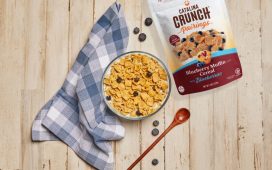
Learn more about the ingredient technology of boozy flavors here.
These flavors are often used in the growing category of better-for-you adult beverages, some of which are no-alcohol, also known as mocktails. There are also low-alcohol options, too, such as new Fun Wine from Fifco USA, Rochester, N.Y. This low-alcohol flavored wine brand was inspired by the hip vibe and culture of Miami. This is showcased in the flavors — coconut chardonnay, sangria and strawberry rosé Moscato — as well as the graffiti-inspired graphics on the new 250-milliliter single-serve slim cans.
Adding “over-21” beverages to prepared foods is a common practice by culinary professionals as well as the home cook. Think cabernet-braised short ribs and beer brats. The alcohol in these beverages not only adds flavor, but it also assists with tenderizing protein.
In other applications flavor extracts often make more sense. Think ice cream, coffee creamer and even donuts.

Year-long ice cream favorites include cake batter vodka martini, hot buttered rum and maple bacon bourbon, with seasonal specialties such as chocolate stout pretzel and salted caramel apple bourbon. For the non-dairy consumer, there are sorbets in varieties such as mango margarita and strawberry white wine sangria.
Recently the Brooklyn location received its liquor license and is now serving boozy ice cream cocktails, beer and wine. Party Like It’s Your Birthday is cake batter vodka ice cream, red velvet martini ice cream and rainbow sprinkles, topped with prosecco. Night Owl features cold-brew coffee and Sweet Baby Java stout over spiked hazelnut coffee ice cream infused with Cafe Patron and hazelnut liqueur, topped with chocolate fudge.
In commercial food manufacturing, formulators may be challenged when it comes to flavoring foods with real “drinkable” alcoholic beverages, as the off-the-shelf product is highly regulated. State regulations, for example, limit how much alcohol may be used to formulate packaged foods. The Bureau of Alcohol, Tobacco and Firearms, a federal agency, requires special taxes to be paid on alcohol, as well as have food formulas approved. Because dealing with regulatory agencies can be timely and costly, product developers often try to trick consumers into thinking they are tasting “the real thing.” This can be accomplished in a variety of ways. Before a formulator chooses an approach, the marketing department must decide what type of language is desired on product labels.
Should the meatballs be called “merlot-flavored” or should they be flagged as “made with real merlot?” If “merlot-flavored” or something similar is acceptable, the easiest and least expensive approach is to use a flavor extract or concentrate. Depending on the application, it may be necessary to use a flavor sensation system that provides the familiar alcohol burn and tingle that somewhat dries the mouth.

Sometimes flavors are used along with ingredients that are very close to the real thing. What this means is that products can be labeled as being made with the real thing, but a food manufacturer does not need to worry about having any employees sneaking tastings. This is because formulators are choosing denatured alcoholic beverages. These contain ingredients such as garlic, onion or salt in concentrations that render them unsuitable for drinking. Denatured liquors are also exempt from state and federal taxes.
Salt denaturation is the most common and often the easiest to work with, as the formulator simply adjusts the salt content of the formulation to account for the salt in the alcohol. To retain as much flavor as possible, it is best to add the denatured liquor as late in the process as possible. Some finished products may contain some alcohol, unless they are heat processed. As long as the alcohol content is less than 0.5%, no alcohol content declaration is necessary.
If it is important that no alcohol be present yet authentic flavor is desired, some suppliers offer reduced alcohol ingredients that are around a 10-fold concentration of the original product. With these ingredients, all of the alcohol and a lot of water have been cooked off. The result is a cost-effective, highly flavorful ingredient.






